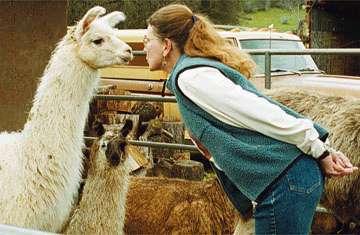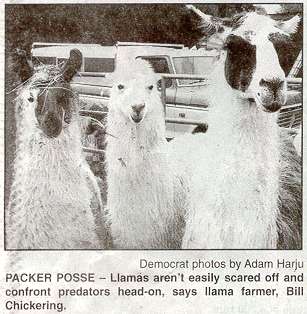 |
Llamas To The Rescue |
| An article in our local paper, The Mountain Democrat, told the sad story of the recent loss of six baby lambs to predators, probably roving dogs or coyotes. The owners of the lambs were broken hearted. They had tried nearly every other strategy to protect their sheep, so we thought that they should know about llamas. Here's the story . . . | |
SANDY CHICKERING, shown here up close with one of her 59 llamas, says the animal can act like guard dogs, and has offered to loan one to the Recchias of El Dorado, who lost six lambs recently to predators. Democrat photo by Adam Haju |
|
Lookout Llamas March 16, 2000 - Lookout llamas By ELIZABETH BUCCERI, Staff writer Local animal lovers across the county are reaching out to help one of their own in a time of need. An article in the March 3 issue of the Mountain Democrat told of the plight of El Dorado resident Gil Recchia, who lost six spring lambs to a rash of coyote attacks several weeks ago, and the article has spawned a number of phone calls from fellow animal lovers with suggestions on how to keep Recchia's furry friends from harm.
Bill Chickering said llamas are the perfect defense against hungry predators -- even better than sheepdogs -- because unlike most farm animals, llamas aren't easily scared off and they confront their potential killers head-on. ``The best animal to have with sheep as a guard is a llama rather than a dog. The dog is naturally a predator,'' he said. The Chickerings, who have raised llamas for about five years, said while sheep and goats have a natural reaction to run when threatened, llamas usually face and charge their attackers. Plus, their enormous size, which ranges from 250-350 pounds, tends to be a deterrent to smaller, but fiercer, coyotes, bobcats, or domestic dogs. Llamas tend to work as a team in emergency situations. Once, a group of visitors arrived on the Chickering's ranch with their dog, which got loose in a pen of adult male llamas and began chasing and barking at them. As one llama backed up and stared down at the unwelcome visitor, two others encroached upon it from either side so that it was completely surrounded. The canine ran as fast as he could out of there, said Bill Chickering. Llamas are naturally protective creatures, and tend to play ``mom'' with animals smaller than themselves, even human beings. Sutter's Mill Llama Ranch often hosts field trips for local elementary schools, and on more than one occasion, the llamas have latched onto small children or children in wheelchairs and followed them around, just in case harm came their way. But the best thing about having a guard llama is they get along so well with sheep,
goats, and other domestic animals, said the Chickerings. They eat the same food and their
fleece can be woven just like wool. And when guarded by llamas, sheep feel safer and more
relaxed, which makes their fleece of a higher quality. ``It has to be something out there with the sheep, like the sheep, but something that responds differently. And that's a llama,'' said Bill Chickering. Besides being great watchdogs, llamas are also great for fire protection, keeping grass trimmed in case a blaze were to erupt. They are also great landscapers Ï eating poison oak, the shoots of El Dorado County's hated yellow starthistle, and other weeds. They require almost no maintenance and are easier to care for than cats or dogs, said Sandy Chickering. And, like cats and dogs, the best reason to have a llama is for love. ``They make good pets and good companions,'' said Bill Chickering. Llamas are native to the Andes in South America, where they are used as pack animals. But they are also used as pack animals here. The Chickerings said they often sell or lease their llamas to campers heading for the Sierra. They are easily acclimated to high altitudes and have soft feet and toes, so they don't damage trails or landscaping. And, contrary to popular belief, llamas don't have bad attitudes and they don't spit at people, just at each other. ``Sometimes you just get caught in the cross-spit,'' said Sandy Chickering. But even with all the benefits of llama owning, Recchia is a little hesitant to open his doors to a llama. He said he is worried about maintenance and having the proper fencing to keep the huge animal contained. But Sandy Chickering said a 4-foot fence is usually sufficient for llamas, who tend to escape only if they need food or see a female nearby. ``As long as they have enough to eat, they don't show that much wanderlust,'' said Sandy Chickering. The Chickerings plan to pay a visit to the Recchia's property to take a look at his facilities and to give him more information about the benefits of using llamas, and they are pretty confident his problems would be solved with one of their furry creatures. ``We want to see if the result is as positive as we think it will be,'' said Bill Chickering.
|
|
More
Info About Guard Llamas |
|


 One such call was from Bill and Sandy Chickering, the owners of Sutter's Mill
Llama Ranch on Luneman Road, who have offered to loan Recchia -- free of charge -- one of
their 59 llamas to help ward off the attackers.
One such call was from Bill and Sandy Chickering, the owners of Sutter's Mill
Llama Ranch on Luneman Road, who have offered to loan Recchia -- free of charge -- one of
their 59 llamas to help ward off the attackers. 